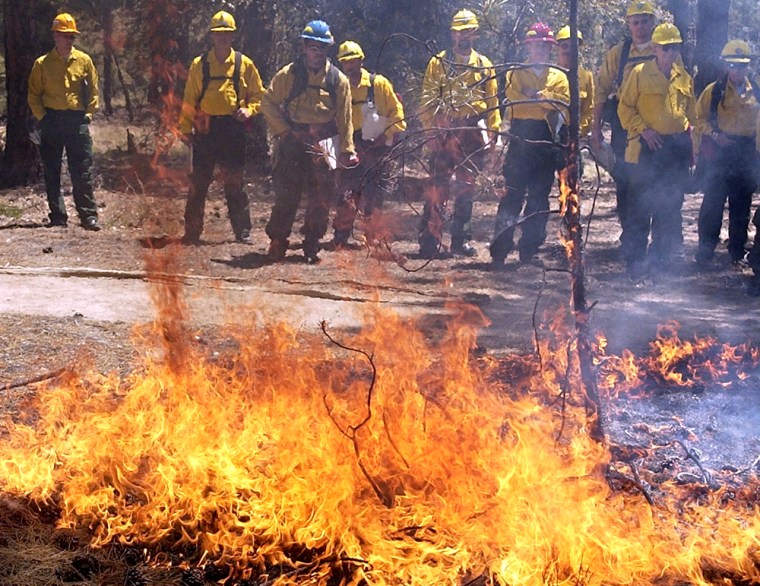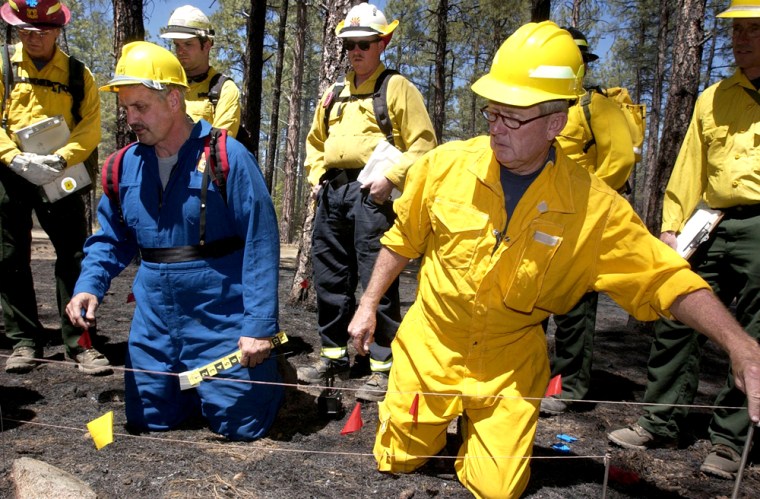On hands and knees with noses nearly touching the ground, six students are hard hat to hard hat, peering at the charred ground.
They’re not exactly sure what they are looking for, but it must be somewhere. Amid the scorched pine needles and blackened forest debris is the cause of this still smoldering fire — if only they could find it.
What the students in the federal wildfire investigation course don’t yet realize is that one of them just stepped on the evidence. Only a single staple from the blackened matchbook was left after the controlled blaze set for the training.
It was a beginner’s mistake, but also an indication of how fragile a fire investigation can be.
Every year, thousands of wildfires burn public lands, and as the drought in the West gives rise to more destructive blazes, the demand for trained fire gumshoes and thorough investigations has only increased.
“We need to equip all our people, with all the resources they need so that every fire gets a good investigation,” said Mike Heath, a senior instructor for the Federal Law Enforcement Training Center, which sponsored the five-day training in Prescott, a pine-studded mountain town 100 miles north of Phoenix.
“When it gets busy, it’s hard to give every fire the attention needed.”
The training center, a division of the Department of Homeland Security, educates about 300 fire investigators a year during training sessions around the country.
The agency has offered the sessions for years, but interest has picked up recently, Heath said. Terrorism fears have brought more students from agencies like the FBI, while large ravenous fires in the West have increased attention from public lands workers.
Training early responders
Some students who attend are seasoned investigators looking to brush up their skills, but others are rangers or firefighters who could be among the first to arrive at a fire.
Training them can help ensure that the site of the fire’s start is preserved for later investigation, said Mike Reamer, a patrol captain for the Prescott and Kaibab national forests.
Most times, the firefighters first responding to a wildfire are preoccupied with finding a safe place to battle the flames, said John “Pancho” Smith, a Forest Service agent who handles Arizona fire investigations.

“Usually what happens is the first fire engine on the scene will be parked on the point of origin,” he said jokingly.
Finding the origin of a fire is a crucial step in determining who started it and whether it was intentional.
In destructive arson fires, the investigations can be used to prosecute perpetrators. The penalty for starting a fire can range from a $100 fine to the cost of fighting a wildfire, which can be in the millions of dollars. If there’s criminal intent, a fire starter can get prison time.
While finding the source of some fires can be more difficult than others, Heath said investigators like to believe there is always something left to indicate how a wildfire started, even amid thousands of acres of burnt land.
What to look for
The evidence can include such easy to miss items as blackened jagged metal fragments, the remnants of welding; or slender straight metal rods, left over from sparklers.
Students are taught “to look for something that doesn’t belong,” Heath said.
The class also covers burn patterns, witness interviews and report writing.
Wildland fires burn in fairly predictable patterns. They generally move in a V-shape away from the source, helping investigators narrow the initial site.
Still, looking for the cause of a wildfire requires patience. After investigators read the burn patterns to narrow the origin site, they’ll carefully comb the area, sometimes using a magnifying glass and magnets.
“This takes a lot of practice. It’s more of an art than a science,” Reamer said.
Robin Thies, an investigation student from the nearby Tonto National Forest, said the classroom information was useful, but the burn investigation exercise gave her a good flavor for how difficult investigations can be.
“In the real world, it’s not that clear,” she said.
Smith, who was attending the class as refresher but has investigated fires for years, said real-world fires add a host of complications, from swirling winds to slurry drops to Hotshot crews crisscrossing the evidence scene.
Even after the source of the fire is determined, investigators must do other police work, like interview people who were hiking or camping in the area and track down those who were in a particular parking lot.
“In the process of all that, there’s another fire and another fire and another fire,” Smith said.
